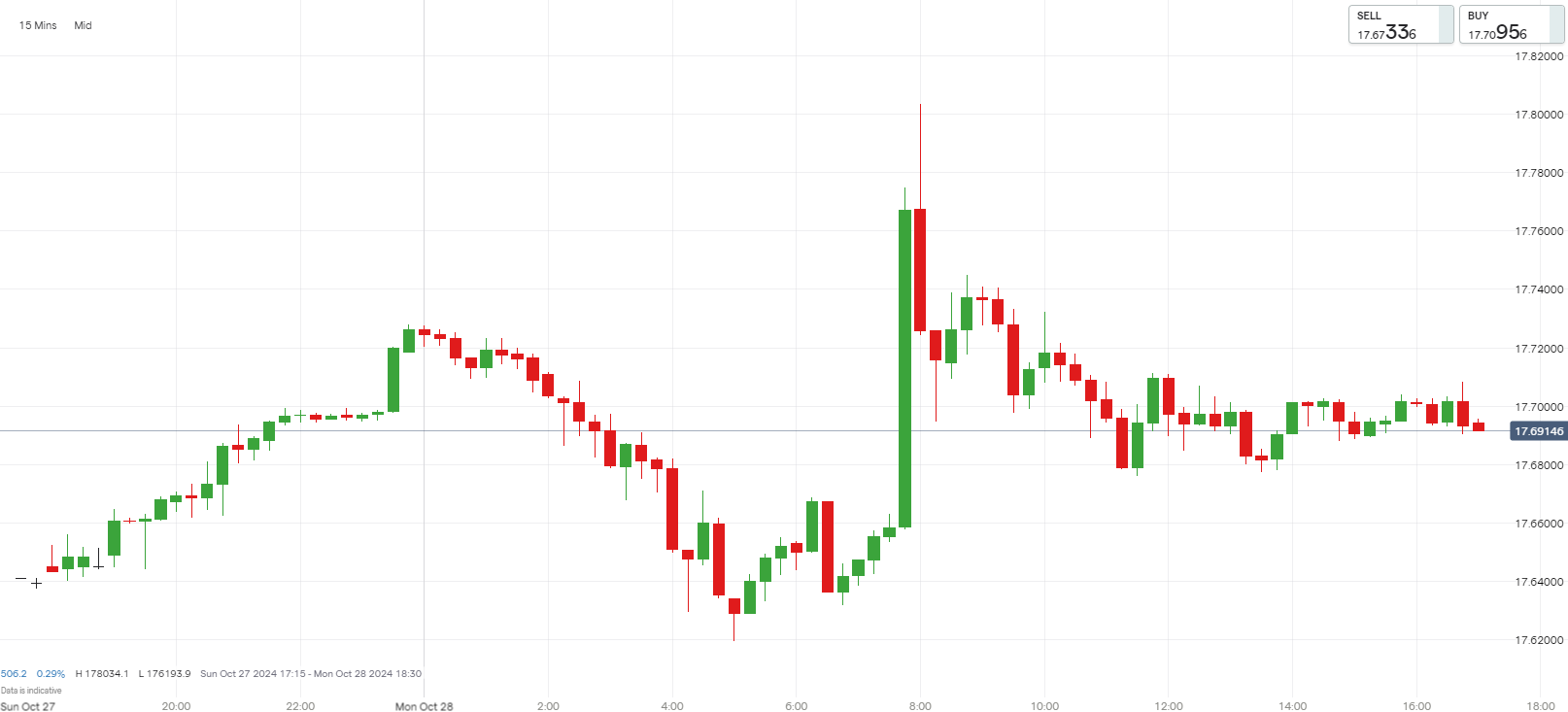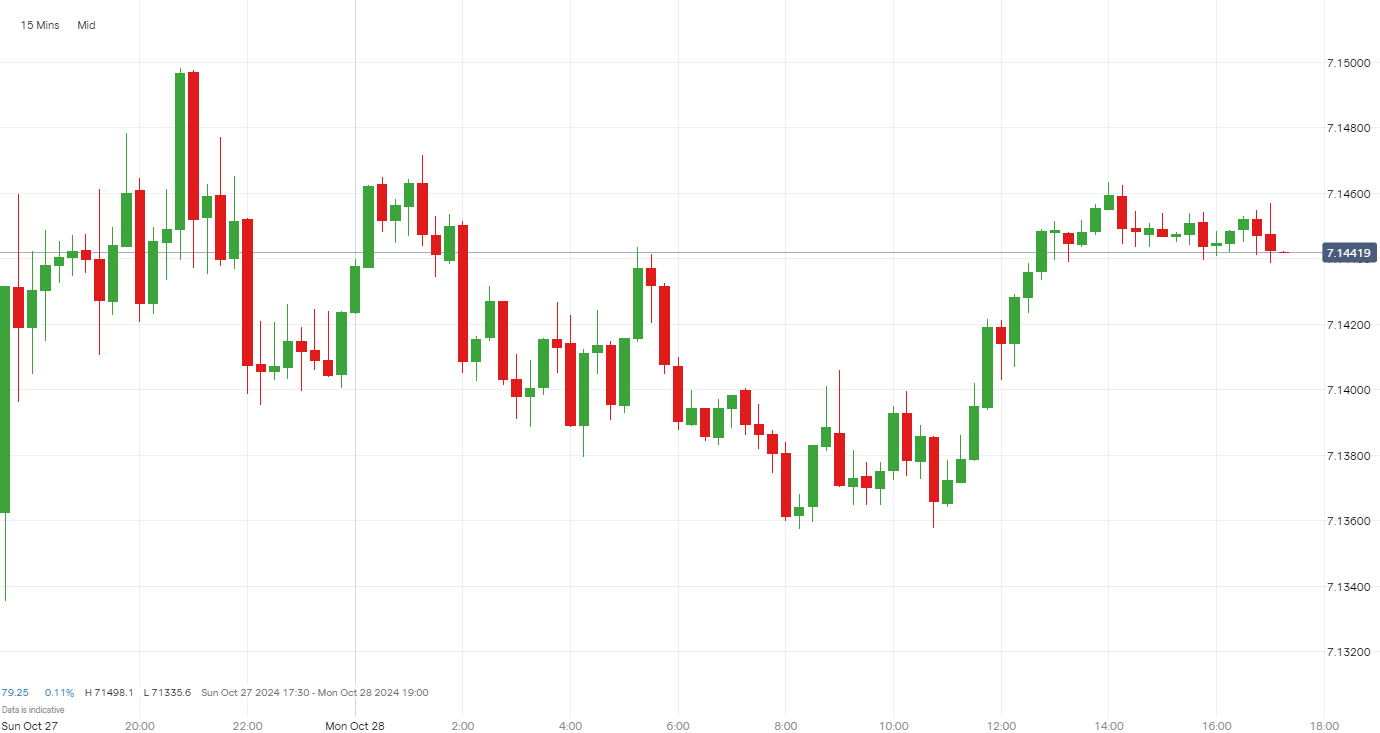Post-BRICS summit price action: USD/ZAR and USD/CNH
BRICS summit highlights growing interest in joining the bloc; USD remains strong amidst economic and geopolitical shifts; South African rand shows modest recovery; USD's future influenced by key global factors.

Key Points
- Over 30 countries express interest in joining BRICS, but integration processes remain undefined
- US dollar index remains near three-month highs, settling at 104.3 amid economic data expectations
- South African rand recovers to 17.67801 per US dollar, supported by a weakening dollar and BRICS involvement
- Offshore yuan weakens to approximately 7.14 per dollar, influenced by US policy expectations and economic challenges
- 96% probability of a 25 basis point rate cut by the Federal Reserve, impacting the US dollar's future trajectory
BRICS Summit Summary
The recent BRICS summit highlighted significant developments, with Russian President Vladimir Putin revealing that over 30 countries have shown interest in joining the bloc. This interest, however, lacks a clear path for integration. The summit also saw BRICS leaders questioning Putin on the Russia-Ukraine conflict, with no immediate resolution in sight. Additionally, Putin warned of potential escalation in the Middle East, signaling geopolitical concerns. Analysts view the summit as an attempt by Russia to strengthen ties with the Global South amid tensions with the West, suggesting economic and financial expansion opportunities for BRICS members.
US Dollar Index Maintains Strength Pre-Economic Indicator Data Releases
The US dollar index stands strong near its three-month highs, settling at 104.3, even amid a slight decline last week. Upcoming economic data releases, including GDP growth figures and the PCE inflation report, are anticipated to impact the dollar. The looming Presidential election further complicates market dynamics, potentially affecting currency valuations due to policy uncertainties. With a 96% probability of a 25 basis points rate cut by the Federal Reserve, traders expect monetary easing to influence the dollar's strength, affecting capital flows and market sentiment.
USD/ZAR Recovers Slightly as USD/CNH Softens
The South African rand has experienced a slight recovery, improving from its one-month low to 17.67801 per US dollar. This recovery is supported by a mildly weaker US dollar, which aids riskier assets by reducing the cost of dollar-denominated debt. South Africa's potential increased involvement in BRICS offers promising prospects, enhancing trade opportunities and economic partnerships with key emerging economies. Concurrently, the offshore yuan's depreciation to 7.14 per dollar reflects China's economic challenges and potential trade tensions, influenced by U.S. policy expectations.
USD/ZAR price history

USD/CNH price history

What’s Next for USD?
The US dollar's future trajectory is shaped by numerous influences, including global economic shifts and domestic indicators. The interest from over 30 countries in joining BRICS suggests possible changes in economic alliances, potentially affecting the dollar's international trade role. Robust US economic data supports the dollar, but potential negative surprises might trigger depreciation. Geopolitical tensions and US-China trade relations further impact the dollar's standing. While the dollar remains strong, its path depends on evolving economic and geopolitical conditions, requiring traders to monitor these factors closely.
How to trade US dollar
- Open an account to get started, or practice on a demo account
- Choose your forex trading platform
- Open, monitor, and close positions on USD pairs
Trading forex requires an account with a forex provider like tastyfx. Many traders also watch major forex pairs like EUR/USD and USD/JPY for potential opportunities based on economic events such as inflation releases or interest rate decisions. Economic events can produce more volatility for forex pairs, which can mean greater potential profits and losses as risks can increase at these times.
You can help develop your forex trading strategies using resources like tastyfx’s YouTube channel. Our curated playlists can help you stay up to date on current markets and understanding key terms. Once your strategy is developed, you can follow the above steps to opening an account and getting started trading forex.
Your profit or loss is calculated according to your full position size. Leverage will magnify both your profits and losses. It’s important to manage your risks carefully as losses can exceed your deposit. Ensure you understand the risks and benefits associated with trading leveraged products before you start trading with them. Trade using money you’re comfortable losing. Past performance is not indicative of future results.
